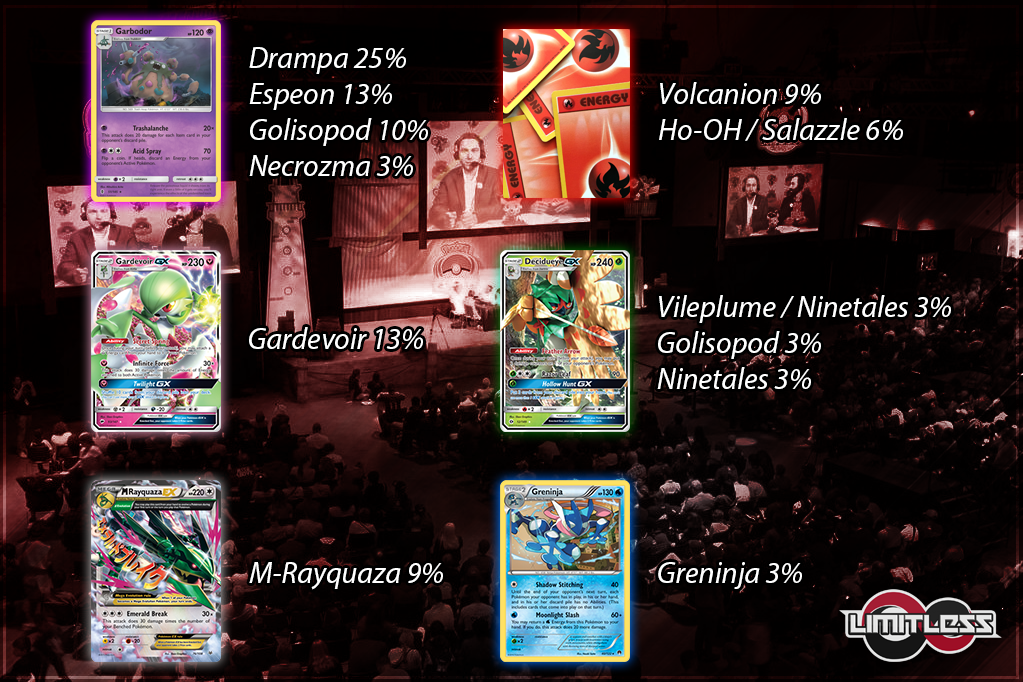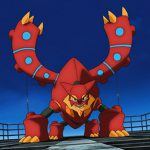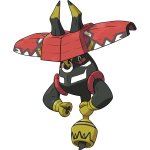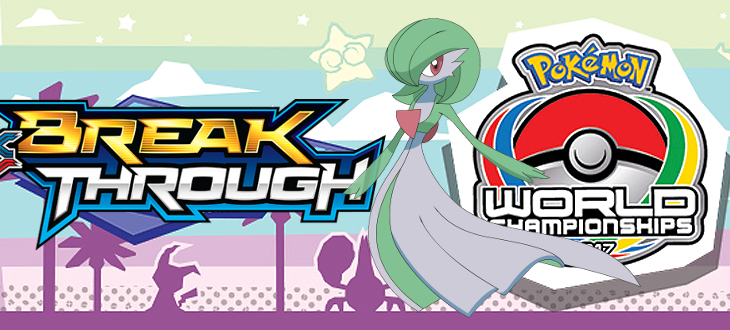With Worlds behind us and the new season approaching, I thought it would be the perfect time to write my first (of hopefully many more) articles for our website. As there haven’t been any tournaments in the current format yet, the natural topic for this entry will be an overview of what I expect the new meta to be like and what I believe will be the best decks.
I’ll start with a first impression and move on to discuss evidence one can use to discuss the format, then I’ll take a closer look at the various decks and round it up with a short conclusion.
1. First impression
Of the many decks we have seen over the course of the last season, three stick out in particular when thinking about the new one – Gardevoir, Volcanion and Garbodor. Not only were these three very popular and successful but they also hardly lost any cards other than of course VS Seeker, and therefore seem likely to still be very strong contenders in the new format.
The deck that sticks out the most is the youngest one of them – Gardevoir. Not only did it win Worlds just after being released, it also had good matchups vs the other two and additionally benefits from the rotation of cards like Forest Of Giant Plants and Dive Ball, because these losses hurt decks that usually were hard to beat (i.e. Greninja and Decidueye).
2. First evidence
The first and basically only data one can use to ground speculations about the new meta, other than private testing of course, are the results from this year’s Worlds. The Worlds format already contained all the cards we have to our disposition now and only few decks rotated out completely – that being Mega Rayquaza, Vespiquen and Gyarados. However, these decks weren’t popular enough to influence either the meta or the outcome of the tournament, and their loss, unlike the one of cards like VS Seeker, Forest Of Giant Plants and Dive Ball, doesn’t change much, other than erasing some potentially bad matchups for a few decks.
The first and most obvious thing we can take away from Worlds is the apparent strength of Gardevoir GX. By winning the entire tournament, the deck demonstrated how well it works and how strong it can be.

The second and more interesting lesson comes from the success and popularity of Garbodor variants. Going into Worlds these archetypes received a huge amount of negative reception. The public opinion almost considered them dead for a while and many doubted their validity because of the release of potentially threatening cards like Gardevoir GX and Golisopod GX. But in the end Garbodor was just as popular and successful as before the release of Burning Shadows and even managed to be very successful in new variations – most notably Golisopod/Garbodor. The huge amount of success these archetypes had (half of the decks in top 32 and 6 in top 8 contained Garbodor) while facing so much anti-hype and many new threats is really a testimony to Garbodors strength. With the rotation Garbodor decks suffer losses again because of the decreasing importance of item cards, but at the same time abilities seem to become more important and Garbodor has already proven how strong it is and how well it can adapt with different variations.
Lastly, I think it’s interesting to note how versatile Volcanion decks can be. The amount of great Fire Pokémon and cards to support them has gotten so big that one can variate Fire decks immensely and adjust them to one’s own preferences and needs. This is beautifully exemplified by Takuya Yoneda and Jimmy Wuyts who took 9th and 10th place at worlds (bubbling with a 6-2 record) with two entirely different Fire builds.
3. A closer look
Starting with the most important deck which is once again Gardevoir. As mentioned before, Gardevoir loses hardly anything other than bad matchups. It has proven to be strong enough to apply a slower strategy and set up a great board containing Octillery as a draw engine and potentially even Gallade to further support that. The consistency that is granted by such a build and the great resource recovery of Gardevoir’s GX attack make the loss of VS Seeker seem truly insignificant. Additionally, Skyla works pretty well to supplement consistency in stage 2 decks and Gallade gives the deck more type coverage and a natural out to cards like Safeguard Alolan Ninetales.
The huge ability reliance might become a problem, but Garbodor typically has been a good matchup anyways and other decks don’t have Hex Maniac anymore. Other than that, the only issue I see is the potential to get countered by decks like Metagross or perhaps Greninja and Decidueye, but that’s simply because the classic Gardevoir/Gallade/Octillery build with a few Skylas to supplement the loss of VS Seeker looks so strong and quite obvious on paper.
 Volcanion is the second deck I expect to be extremely powerful. It’s generally very consistent and versatile, having a big arsenal of great, mainly basic, attackers (baby Volcanion, Volcanion EX, Turtonator GX, Hooh GX, Salazzle GX) at its disposal and various possibilities to accelerate Energies (Power Heater, Nitro Tank GX, Kiawe, Max Elixir), the deck is fast and hits hard while even being able to cover its weakness thanks to Hooh GX. Another strong point is that it often finishes its games in just few turns without the need of many supporters.
Volcanion is the second deck I expect to be extremely powerful. It’s generally very consistent and versatile, having a big arsenal of great, mainly basic, attackers (baby Volcanion, Volcanion EX, Turtonator GX, Hooh GX, Salazzle GX) at its disposal and various possibilities to accelerate Energies (Power Heater, Nitro Tank GX, Kiawe, Max Elixir), the deck is fast and hits hard while even being able to cover its weakness thanks to Hooh GX. Another strong point is that it often finishes its games in just few turns without the need of many supporters.
All of this leads me to the conclusion that Volcanion will surely find its way to the top of the tier list in some form or another. The new Hooh/Salazzle build looks very appealing to me because it puts so much pressure on its opponents using Kiawe and needs little cards to take the last prizes in the late game. Depending on how consistent this strategy works in practice, it might be able to beat anything handily. However, the straightforwardness of that build might hurt it pretty badly once it whiffs something and a more typical and steady build focusing on baby Volcanion and Starmie might end up being better.
The biggest problem one needs to solve in order to play Volcanion, and therefore what should define how one’s build looks like, is the tough Gardevoir matchup. A version that can deal with it well or even beat it handily can surely go all the way in a tournament.
Even though I spoke quite highly of Garbodor until now I’m pretty uncertain about its place in the meta. I see the deck’s biggest strength in Garbotoxin because the amount of abilities appears to be huge with Gardevoir and Volcanion being this strong, potential counter decks like Metagross, Decidueye and Greninja around, Vikabulu (which I’ll discuss next) on the rise and increased importance of draw abilities like Octillery’s and Oranguru’s. As seen in the past, Garbodor decks can adapt very well and with Garbotoxin they have a solid basis to build upon. A spread build with Tapu Koko, Necrozma GX and Espeon EX like the one Reiji Nishiguchi used might be good at exploiting slow set ups and effective at dealing with stage 2 decks, the classic Espeon and Drampa variants are always a threat to count on and the new Golisopod version might shine as well, even though I’m particularly skeptical of that one because of the reduced availability of all Acerola, Guzma and draw Supporters.
Personally, I think the Toolbox like spread build looks the most promising, but it’s imaginable that none of the above will be able to become real tier 1 decks. With VS Seeker and other item cards like Level Ball and Trainer’s Mail gone, the damage output of Trashalanche is reduced immensely and typically tough matchups like Gardevoir and Volvanion appear to be stronger than ever. However, the loss of VS Seeker also reduces the availability of N and therefore the control over one’s items and you should never be surprised to see a Garbodor deck do well.
 Vikavolt/Tapu Bulu didn’t really stick out so far but it has been a generally solid deck all along and the rotation virtually doesn’t hurt it at all. Replacing VS Seekers with more Skyla fits the deck naturally because it really only needs to set up a Vikavolt and then plays from the board. The deck has always been very fast and good at overwhelming opponents completely, which is a quality that comes to shine in a supposedly slower format like this one. I certainly could see a consistent and straightforward build with a few Tapu Kokos to set up KOs on bigger Pokémon perform very well.
Vikavolt/Tapu Bulu didn’t really stick out so far but it has been a generally solid deck all along and the rotation virtually doesn’t hurt it at all. Replacing VS Seekers with more Skyla fits the deck naturally because it really only needs to set up a Vikavolt and then plays from the board. The deck has always been very fast and good at overwhelming opponents completely, which is a quality that comes to shine in a supposedly slower format like this one. I certainly could see a consistent and straightforward build with a few Tapu Kokos to set up KOs on bigger Pokémon perform very well.
The only downsides I see is the deck’s straightforwardness and predictability, which might keep it from standing at or close to the top.
And finally, there are the anti meta picks I mentioned a couple of times. Let’s start with Metagross as it is the hardest Gardevoir counter you could wish for. Metagross has always been a deck that has to commit so much space to its set up that it has to rely entirely on naturally good matchups and therefore I don’t think it can become a real tier 1 deck. However, stage 2 decks lost comparably little consistency and as long as Volcanion isn’t too popular the meta might shift into a direction that makes Metagross a good play.
The other two decks I’d like to discuss here are Decidueye and Greninja. Those two used to be on the clunkier side of the meta spectrum and with the rotation they lose cards that were important for their setup. Therefore, it is no surprise that they are now considered to be rather weak decks, but of course it is not a given that Greninja can’t set up without Dive Balls, or Decidueye without Forest Of Giant Plants, Level Ball and Shaymin EX. As long as these two can commit enough space to other consistency cards (i.e. Skyla, Rare Candy and other Pokémon search) and still set up, they are extremely strong and play from the board, therefore compensating their losses. The biggest chance I see for these two is the strong Gardevoir matchup and therefore the possibility to exploit a favorable meta. However, they are pretty easy to counter and will probably not be able to establish themselves as top decks.
4. Conclusion
As I said a couple of times already, Gardevoir seems like the strongest deck to me. It definitely is BDiF material and already won Worlds, it benefits from the rotation on the one side because Skyla supplements consistency so well in stage 2 decks as opposed to most others, and on the other hand it got rid of quite a few tough matchups. But unlike many other decks, it is already a very defined deck, there is hardly any way around the standard Octillery/Gallade build and therefore everyone knows what’s coming and Gardevoir is at risk of running into field full of counter decks, dreadful mirrors and opponents that are prepared to beat it.
This is where Volcanion and Garbodor get to shine as extremely powerful and versatile archetypes that can come up with creative builds and take a tournament by surprise.

